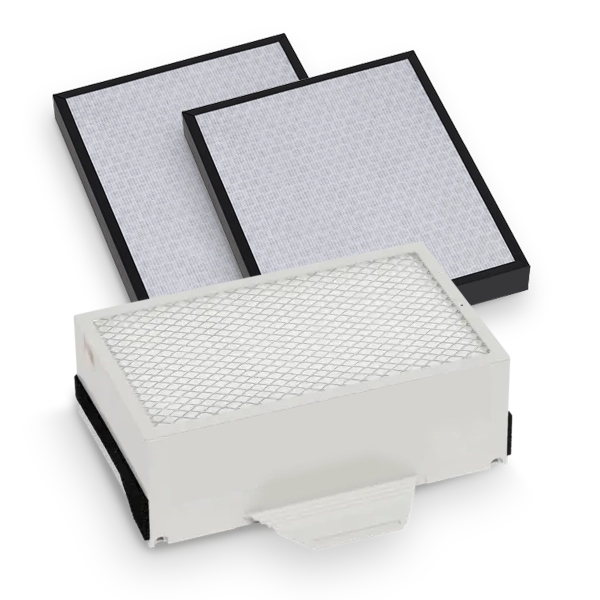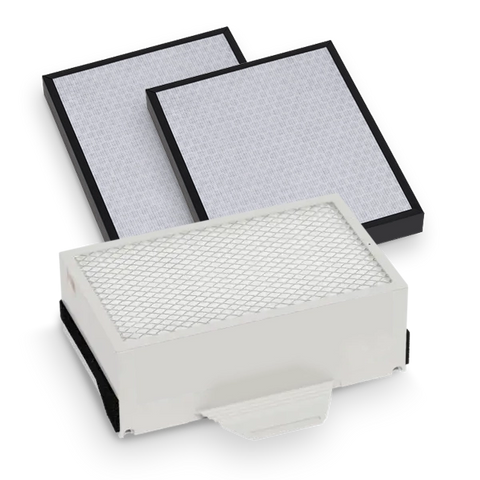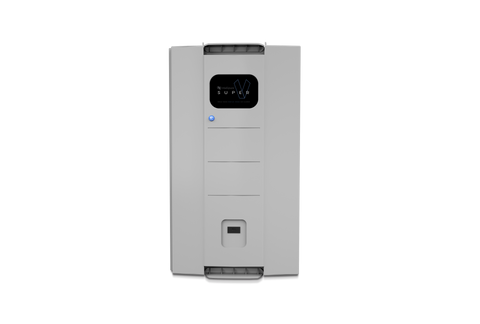There’s a lot of discussion around ways to live healthier. A good diet, routine exercise, plenty of sleep and being mindful of one’s living environment are all positive things. It seems like everyone is making sure to drink plenty of clean water thanks to the proliferation of reusable water bottles everywhere. But what about making sure you are breathing clean air? Does an air purifier really make the air inside your home better for you? Do air purifiers actually work? We’ll take a look at the benefits, effectiveness, types, and limitations of air purifiers so you can decide for yourself.
What Is An Air Purifier?
An air purifier is simply any device designed to clean indoor air by removing airborne pollutants. Most air purifiers rely on mechanical filtration (like HEPA filters) to catch airborne particles. Some air purifiers use activated carbon filters to capture chemicals and volatile organic compounds (VOCs). Other ways to improve indoor air quality include ionic air purifiers, UV purifiers, and electrostatic air purifiers. There are small portable air purifiers meant for single rooms all the way up to whole-house air purification systems.
Air purifiers are rated by their clean air delivery rate (CADR), which is how many cubic feet of air is cleaned per minute. For example the Intellipure Compact has a PM2.5 CADR of 137.5 cubic feet per minute at its highest fan speed setting (Turbo). That means the Compact will clean all the air in an average 12’x12’x8’ bedroom at least 8 times per hour!

Air Purifier Health Benefits
There are many health benefits for using an air purifier in a home, office or business. Here are are a few noteworthy reasons:
Fewer Airborne Allergens
Part of indoor asthma management is making sure your air is clean to breathe. When it comes to reducing allergy and asthma symptoms, an air purifier is a mighty ally. Triggers such as pollen, mold spores, dust mites, and pet dander can all be severely curtailed with the right air purifier. For these allergens you need a good mechanical filter that is at least HEPA rated or the equivalent performance. Research has shown that an air purifier can be effective in controlling triggers for allergic respiratory diseases.
Reduced Dust and Mold
Capturing fine particles like dust means there is less of it to float around in the air and settle on your coffee table. While dust is always being created (it is mostly made from dead skin cells and hair) running HEPA air purifiers on a constant basis drastically reduces dust amounts. By also capturing mold spores an air purifier stops the main mechanism mold uses to spread: airborne dispersal. Research has shown that air purifiers are effective at capturing particle pollution such as dust and mold spores.
Improved Cardiovascular Health
For those who suffer from cardiovascular issues like chronic obstructive pulmonary disease (COPD) an air purifier can help improve certain health concerns. Studies have shown that people using an air purifier had their COPD symptoms improve over time. PM2.5 particles have been linked to inflammation in the lungs, so removing them from the air is a priority.
Better Respiratory Health
Harmful pollutants and airborne particles containing viruses can lead to upper respiratory and lung issues. Removing illness causing microorganisms from the air helps reduce the spread of diseases and lowers the chance of getting sick. Research supports that air cleaners are effective at capturing airborne diseases. Other technologies such as UV sterilization can be effective at deactivating microorganisms, but must be carefully monitored as some UV light source methods may emit ozone. Third party testing shows the Intellipure Compact was able to reach a 99.99% reduction of the sample microorganisms.
Respiratory Protection
For certain air pollutants an air purifier can help protect vulnerable individuals such as young children, the elderly, and those with preexisting respiratory issues. Research shows that even healthy individuals who live in polluted areas can benefit. An air purifier that combines a HEPA-level filter with an activated charcoal filter can help remove harmful VOCs like those found in wildfire smoke or tobacco smoke.
These health benefits come from improved indoor air quality as long as the air purifier has a sufficient CADR for the space. Make sure the air purifier has sufficient CADR to clean all the air in the space at least four times per hour.

Effectiveness Of Air Purifiers Against Contaminants
When it comes to removing airborne pollutants for better indoor air quality, an air purifier can be an indispensable tool.
Air Purifiers Versus Allergens
When it comes to capturing animal dander, pollen, mold spores, and dust mite waste an air purifier with HEPA filters shines. Research has shown that HEPA level filtration can drastically reduce airborne allergens. Allergens like pet dander tend to fracture into tiny pieces which makes them difficult to capture unless a high-quality filter is used. Pollen grains can be large and occur in high quantities, which is why an air purifier with a pre-filter can be useful.
Air Purifiers Versus Fine Particulates
Most commonly used home HVAC filters have a MERV rating of 8. This is sufficient to protect the HVAC equipment, but does not capture fine particulate matter (PM). Pollutants in the PM2.5 range mostly sail right through a MERV 8 filter and unfortunately can settle deep in your lungs. By contrast the Intellipure Compact air purifier has a particle capture efficiency of 99.99% @ 0.007 micron.
Air Purifiers Versus Smoke
Smoke is a complex pollutant that includes not just fine soot particles but also potentially harmful gaseous pollutants. Indoor smoke is usually easy to avoid by using proper ventilation, but outdoor smoke is more difficult to control. In the case of wildfires it can also travel great distances affecting large areas nowhere near the original fire outbreak. Using an air purifier with both HEPA-level mechanic filters and activated carbon filters maximizes the pollutants that can be removed from the air.
Air Purifiers Versus Chemicals
Harmful VOCs are all around us. Sources include home furnishings, household chemicals, flooring/carpet, bedding, even air fresheners. While HEPA filters may catch tiny particles, they are not designed to capture chemicals or gases. You need an air purifier with a VOC filter like the Intellipure Compact that can help reduce harmful airborne chemicals.

Types of Air Purifiers
There are a wide variety of air purifiers on the market today. Most fall into the following categories:
Mechanical Filter Air Purifier
This is the most common type of air purifier you are likely to encounter. It uses a filter made up of a random fine fiber mesh (commonly polypropylene or fiberglass) to physically capture airborne particles that flow through it. For portable air purifiers HEPA filter media is the most commonly used. Whole-home air purifiers are available that are specifically designed to work with a HVAC system. Simply replacing an existing HVAC filter with a much higher MERV rated filter can actually cause heating/cooling or ventilation problems, which is why a whole-home air purifier must be carefully engineered.
Adsorbent Filter Air Purifier
Mechanical pleated filters are great at catching particles, but they do almost nothing to catch chemicals and VOCs. These contaminants require a special activated carbon filter that captures chemicals to remove them from the air. Many air purifiers use multiple filters to clean the air, one which is HEPA-level rated and another that uses activated charcoal. This allows each filter type to focus on capturing a specific pollutant. It also allows for differing maintenance schedules if one filter outlasts the other.
Ultraviolet Light (UV) Air Purifier
UV light is very effective at disrupting the ability of microorganisms to multiply by damaging its cellular DNA and RNA. Specifically UV-C light in the 180-280 nm wavelength range is found to be the most effective. As bacteria, viruses, and mold pass by the UV light source, they are permanently damaged. The same damage can also affect humans, so the UV light source must be shielded to prevent accidental exposure. Effectiveness depends on UV light exposure amount, so airflow can’t be too fast. Unfortunately some UV light sources can give off ozone as a byproduct. The UV light source itself can also lose effectiveness over time and must be replaced. UV light disinfection is also popular for water treatment.
Ionizing Air Purifier
Electronic air cleaners rely on ion generators to induce a charge on nearby airborne particles. These particles are then attracted to a nearby surface (often collection plates within the air purifier) where they gather. The collector plates must be cleaned regularly to prevent the particles from becoming airborne again. This type of air purifier also does not remove chemicals or odors. Also depending on the technology used they may create ozone gas as a byproduct.
Ozone Air Purifier
While ozone is recognized as a pollutant, it is also used for odor removal under certain conditions. Technically an ozone air purifier is an ozone generator. The ozone gas reacts with odors and neutralizes them. Ozone is harmful to living organisms so this type of air cleaner is typically used under strictly controlled conditions to prevent harm. It also does not physically remove any particles from the air like filtered air purifiers do.
While all of these air purifiers may work differently, they are all rated by their CADR rate. The higher the CADR, the more air it can clean effectively.
Air Purifier Limitations
In the pursuit of better indoor air quality it may seem like a good idea to use any air purifier you find on sale, but that isn’t the best advice. Whether they are portable air purifiers or whole-home units, each type of air purifier has a limit to what it can remove from the air.
Mechanical Filter Air Purifier
While a HEPA filter can catch tiny particles, it cannot catch gaseous pollutants. Fine particles like soot from smoke can be captured, but the gaseous components of smoke are not. Eventually the surface of the filter will become clogged with particles and no longer effective.
Adsorbent Filter Air Purifier
An activated charcoal filter is good for odor and VOC removal, but it typically cannot capture tiny particles like HEPA purifiers are able. Timely filter replacements are required or they will lose their effectiveness as the adsorbent surface area becomes saturated.
Ultraviolet Light (UV) Air Purifier
A standalone UV light air purifier does not capture any pollutants, it only deactivates microorganisms. Regular maintenance of the light source is also required, as some types lose effectiveness over time. The light itself must also be shielded.
Ionizing Air Purifier
These types of air purifiers actually have a harder time catching larger particles. They also require attention to humidity control as moist air can hamper performance. For complex issues like wildfire pollutants ionizing air purifiers may catch the soot particles, but accompanying gases will be unaffected.
Ozone Air Purifier
Ozone generators do not physically remove any particles from the air. They also cannot be used in the same area as any living things due to the toxic nature of ozone.

Other Indoor Air Cleaning Methods
While an air purifier is a highly effective form of air cleaning, there are other options for specific situations.
Air scrubber
If the air is really dirty such as during construction, remodeling, or remediation a portable air scrubber may be the best choice. An air scrubber is typically commercial grade designed to clean as much air as possible with little concern for appearance or noise level. Particle capture range can be MERV 1-16 all the way up to HEPA filters depending on the job. Filters with adsorbent media such as activated carbon are also available. Your local tool rental store can likely help out if you need one for a project.
House plants
While your house plant won’t sweep the floors, it can actually help clean the air. Naturally plants absorb carbon dioxide and give off oxygen in return. They can also absorb pollutants like VOCs such as formaldehyde, benzene and toluene. Some particle collection may also occur on the leaf surfaces.
Ventilation
Sometimes one of the best indoor environmental control practices is to open a few windows. This trick only works if the outdoor air quality is better than the current indoor air quality. Be aware of what is in the outside air though or else you will turn outdoor allergens into indoor allergens. Also pay attention to the outdoor humidity level if you are running a dehumidifier, as you don’t want to waste energy drying the neighborhood.
Baking soda
There was a time when nearly every refrigerator had a box of baking soda sitting in the back. Baking soda is an excellent adsorbent media for removing mild odors. Chemically baking soda is alkaline, so when it contacts smelly acidic molecules they are neutralized. It is limited in its uses to mainly acid-based smells.
HVAC system
Some HVAC systems can use high-efficiency media filters with a higher MERV rating. While this will capture more particles that pass through the HVAC system, there are tradeoffs. Most home HVAC systems are not designed to move air through a high MERV rated or HEPA filter. It takes more effort from the fan motor to move air through one of these filters, which can lead to less air flowing through the system. This can lead to heating/cooling imbalances and increased energy usage as the fan motor works harder. It is best to consult with a HVAC expert to find out the maximum MERV rated filter your system can handle.
Conclusion
In short, air purifiers do work to clean the air. Which kind you choose makes a difference though. For the best possible indoor air quality the Intellipure Compact removes up to 99.97% of allergens, mold, and viruses from the air. It is tested to meet or exceed the HEPA standard thanks to proprietary DFS technology. It features a multi-stage pre-filter that captures harmful gases and odors. When it comes to your home’s indoor air quality, Intellipure is your trusted partner.








